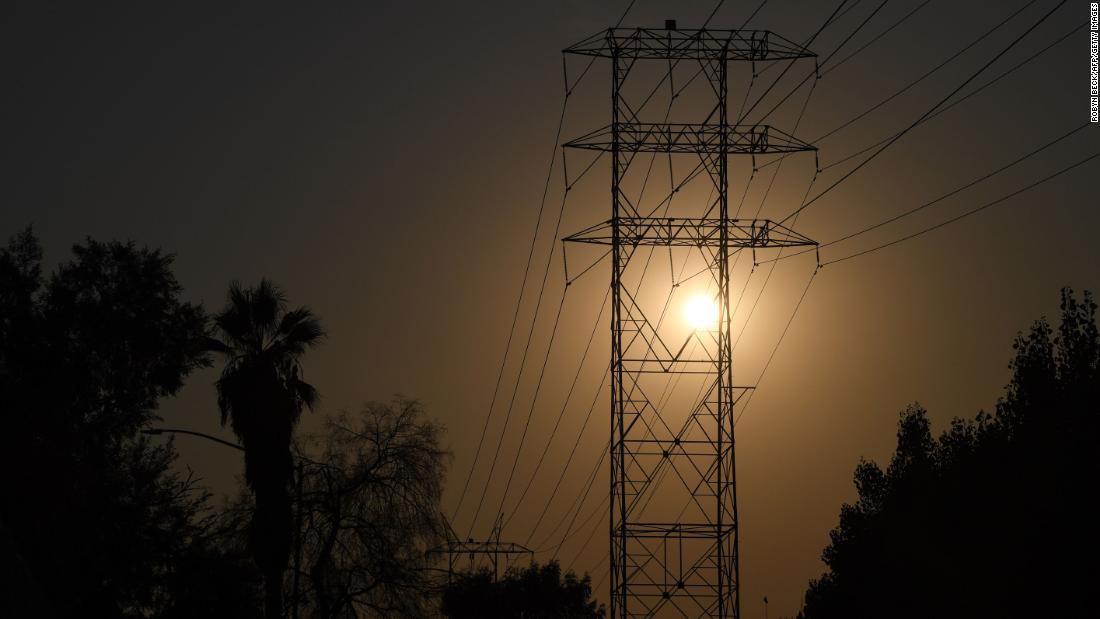
More than 11 million residents, from the central coast to southern California, were under the red flag because of the winds exacerbating fire risk. And nearly 150,000 customers were out of power on Tuesday due to a combination of downed trees and power lines, and utility companies proactively cutting power to prevent fires.
The wind at the highest point of the High Sierra had reached more than 100 mph on Tuesday. Strong gusts of wind in excess of 50 mph were reported at San Francisco International Airport.
Several hurricane-force gusts were reported on Tuesday in the mountains of Southern California’s Ventura and Los Angeles counties. The cause of the high winds: the combination of a developing storm off the coast of California and strong high-pressure build-up in the western US.
The wind was expected to decrease slowly on Wednesday.
On Monday, gusts of over 90 mph were reported from Sacramento to the Bay Area, with one gust to 160 mph near Kirkwood, east of Sacramento. A 90 mph gust was even reported in Tahoe, with winds in excess of 60 mph extending along the coast.
To put that in perspective, the category 1 wind is 74 to 95 mph and the category 2 wind 96 to 110 mph. This means that California gusts can reach speeds equivalent to a strong Category 2 hurricane.
According to SCE: “When there is a high risk of a wildfire, we can temporarily turn off the power to your neighborhood to prevent our electrical system from becoming the source of ignition.”
“With nearly 80% of the western US experiencing drought, the area resembles a tinderbox,” said CNN meteorologist Pedram Javaheri.
Fires would flourish
The wind could be the strongest wind event of the season, forecasters say – which could make an eruption even more dangerous.
“The combination of dry fuels and tropical storm winds can lead to downed trees and power lines, so any ignition of new fires would flourish and expand rapidly under these conditions,” Javaheri said.
Many Southern California locations, including Los Angeles, have not seen measurable rainfall since late December, meaning the region’s vegetation has had more than two weeks to dry out.
Southern California has also seen record heat in recent days, in addition to growing drought in the region.
And the wind expected to reach the region is the kind seen only every three years, San Diego’s National Weather Service said.
Nearly 30 million Californians, or about 3 in 4 people in the state, could see high winds until Tuesday, Javaheri said.
Climate change adds fuel to the fire
With warmer temperatures and less constant rainfall, wildfires are becoming more dangerous and more common. The number of areas burned by wildfires is on the rise in the US, especially in the Western states.
According to the US National Climate Assessment, annual burnt areas in the western US could be two to six times the current level.
“What is happening in California right now is a perfect example of how the Wildfire Season has grown in length throughout the Western US,” said CNN meteorologist and climate expert Brandon Miller.
Although wind events in Santa Ana generally occur from October to March, there is usually only dangerous firefighting in the first few months.
“In January, Western states should be well into the rainy season and moisture levels would be high enough to keep the fire risk low,” says Miller.
With record-breaking fire seasons in recent years, “California firefighters are no longer referring to a ‘fire season’, but rather a ‘fire year,’ as climate change has extended the length of the season on both sides.” Miller said.
A chance of wet weather
There could be some good news later in the week because if the storm sweeps through Southern California on Wednesday, it could leave behind a goodbye gift of moisture, Javaheri said.
A low-pressure system developing offshore can provide cooler temperatures and higher humidity values. And more moisture could mean the weather to extinguish the parched southwestern area.
In Arizona, Phoenix had a streak of 242 days without rainfall and Yuma a streak of 110 days until both cities experienced rainy days on December 10.
Reducing widespread drought in the region could provide relief from potential fire conditions.
CNN’s Haley Brink contributed to this report.